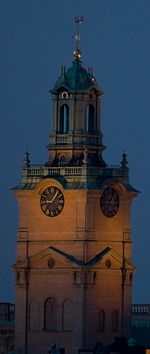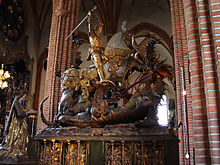Sankt Nikolai kyrka
The Sankt Nikolai kyrka ( German : St. Nikolai Church or Nikolaikirche ), often also Storkyrkan (the Great Church) , is the cathedral church of Stockholm within the Evangelical Lutheran Swedish Church . It is located in the old town ( Gamla stan ) near the Royal Castle (Kungliga slottet) . The entrance is in the west on Trångsund , the choir faces east to the castle square (Slottsbacken) . In the north, the street Storkyrkobrinken separates the church from the castle; in the south, the churchyard is followed by the former stock exchange building, now the Nobel Museum .
history
According to tradition , the church consecrated to St. Nicholas was built by Birger Jarl , the founder of Stockholm, in the middle of the 13th century on the highest point of the island of Stadsholmen . In any case, parts of the foundation date from this time. The church was first mentioned in a document in 1279. After significant renovations and extensions in the 14th and 15th centuries, it reached its present size and shape as a five-nave hall church in 1480. The Swedish reformer Olaus Petri was first a preacher, then the parish priest of St. Nikolai, which in 1527 was finally made an Evangelical Lutheran Church. At the end of the 17th century it received its baroque interior and was plastered. In 1908, the plaster was removed from the pillars in order to give the building back its medieval character.
The Swedish kings were crowned here, as the last King Oskar II on May 12, 1873. His successor Gustav V ended this tradition in 1907. The so far last royal wedding took place on June 19, 1976 between Carl XVI. Gustaf and the German Silvia Sommerlath in the church. Her daughter, Crown Princess Victoria of Sweden , also married Daniel Westling in the Nikolaikirche on June 19, 2010, with great media attention .
In 1942 the diocese of Stockholm was formed, with the Nikolaikirche elevated to the status of cathedral. It is usually not referred to as the Nikolaikirche, but simply as the Storkyrkan . It is the parish church of the residents of Gamla Stan. After a reorganization, the nearby Klarakirche and the Jakobskirche were also included in the cathedral parish in 1989 , but it still has fewer than 3,000 parish members. Since its elevation to the cathedral church, the following people have presided over:
As pastor primarius:
- 1943-1958: Olle Nystedt
- 1959–1970: Åke Zetterberg
- 1970–1972: Åke Kastlund
- 1972–1979: Lars Carlzon , Bishop 1979–1984
- 1980–1985: Ludvig Jönsson
- 1986–1989: Gösta Wrede
As Provost:
- 1990–1998: Caroline Krook , Bishop 1998–2009
- 1999-2001: Tony Guldbrandzén
- 2001-2003: Lennart Koskinen
- 2003-2006: Hakon Långström
- 2006–2012: Åke Bonnier the Younger
architecture
The church was originally built in the brick Gothic style of the 13th century with a tower. In the years 1736 to 1742 the still visible redesign as a plastered building in baroque style was carried out by the architect Johann Eberhard Carlberg, as the church was to harmonize with the recently built castle in the immediate vicinity. The church tower is 66 meters high and houses four church bells, the largest of which weighs 4.5 tons.
In 1898, the bronze statue of Olaus Petri by Theodor Lundberg was erected in front of the church on Schlossplatz .
Furnishing
The ebony altar is a triptych and is often referred to as a silver altar because of its silver reliefs . It was given to the church by councilor Johan Adler Salvius and his wife around the middle of the 17th century. The middle panel comes from Germany, while the wings were made in Stockholm. After the image of the Last Supper on the predella , the largest and lowest silver relief shows the crucifixion of Christ between the statues of Moses and John the Baptist . Above it follows the relief with the entombment of Christ between the statues of Matthew and Mark and finally the relief with the depiction of Christ's descent into hell between the statues of John and Luke . At the top of the altar, the figure of the risen Christ crowns the work of art. The stained glass rose window above the silver altar comes from Paris and was created in the mid-19th century.
The sculptural group of Saint George with the dragon , made in 1489 by the Lübeck artist Bernt Notke on behalf of the Swedish imperial administrator Sten Sture to commemorate the Battle of Brunkeberg, is undoubtedly the most spectacular work of art in the church. It was carved from oak wood. The figure of Georg should symbolize Sten Sture, the dragon the Danish king and the princess the saved city of Stockholm. In 1912 a copy was placed on the Köpmantorget , a small square in the southern old town of Stockholm. A plaster cast of this colossal group is in the St. Katharinen Museum Church in Lübeck.
The seven-armed bronze candlestick is 3.70 meters high and was probably made in Germany in the 15th century.
In the north aisle hangs a monumental painting depicting the Last Judgment by David Klöcker Ehrenstrahl from 1696, whose grave is also in the Nikolaikirche. It was originally created for the palace chapel, but was given to the Nikolaikirche in 1777.
In the central nave there are two magnificent royal chairs that are used as boxes exclusively by members of the royal family when they attend official celebrations in the church. They were designed by Nicodemus Tessin the Younger in 1684 and made in wood by Burchard Precht.
The pulpit in the French Baroque style was also made by the sculptor Burchard Precht from around 1700. Below is the grave slab of the Swedish reformer Olaus Petri.
On the wall of the south aisle hangs the painting called Vädersolstavlan , which, commissioned by Olaus Petri, shows a spectacular sun and halo appearance over Stockholm from 1535. The depiction of Stockholm that can be seen is also the oldest surviving view of the city. The original picture has been lost, the painting on display is a good copy from the 1630s by Jacob Heinrich Elbfas and is of great importance for the history of Stockholm.
organ
The main organ on the west gallery consists of a historical, richly decorated and gilded organ case , which was built in 1796, and an organ, which was built in 1960 by the Danish organ building company Marcussen & Søn . The instrument has 53 stops on four manuals and a pedal . Both the playing and stop actions are mechanical.
|
|
|
|
|
||||||||||||||||||||||||||||||||||||||||||||||||||||||||||||||||||||||||||||||||||||||||||||||||||||||||||||||||||||
- Pair: I / II, III / II, IV / II, I / P, II / P, III / P, IV / P
Individual evidence
- ↑ theorganmag.com: The organs of the Storkyrkan, Stockholm (engl.)
Web links
Coordinates: 59 ° 19 ′ 32.8 " N , 18 ° 4 ′ 13.4" E






